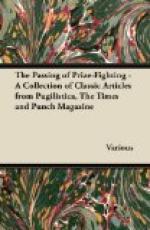Yours sincerely,
Arthur
K. Wilkinson.
The receipt in full, which reached me in reply, was very satisfactory. The pork was delicious.
* * * * *
[Illustration: Country Postman. “I’m sorry, Ma’am, I seem to have lost your postcard; but it only said Muriel thanked you for the parcel, and so did John, and they were both very well and the children are happy and she’ll give your message to Margery. That’ll be your other daughter, I’m thinkin’?”]
* * * * *
FLOWERS’ NAMES.
Lady’s Bedstraw.
Under two secret arching hedges
Masses of Bedstraw grow,
Silvery-white among the sedges,
Like drifts of fairy-snow;
Deep’s the middle, fringed the edges;
Who sleeps there? Do
you know?
Do you? Or you?
Hark! for the breezes know.
“Oh, there my Lady Summer lies
Adream beneath cool April skies;
About her blossoms fall
On her long limbs and secret eyes.
Still she sleeps, virginal;
Then—hark!
June’s clarion call!
She lifts her wistful wilful eyes,
Springs light afoot and away she flies.
But her Bedstraw dies.”
* * * * *
“We have received from
—— Manufacturing Company, New York,
makers of Distructive Stationery
for Social Correspondence,
copies of their artistic Wall
Calendars.” West Indian Paper.
The calendars don’t interest us, but a few samples of the “distructive stationery” would come in useful for answering bores.
* * * * *
NOCTURNE.
Of course I suppose I ought to be grateful for the opportunity of having a front seat at one of Nature’s romances, but I imagine she reaps more applause at matinees than at soirees. I know that I—But judge for yourself.
The dramatis personae were corncrakes, neighbours of mine. The heroine—a neat line in spring birdings—I labelled “Thisbe,” and she had evidently inspired affection of no mean degree in the hearts of two enthusiastic swains, Strong-i’-th’-lung and Eugene. I know all this because Thisbe’s home is a small tuft of grass not distant from my bedroom, and her admirers wooed her at long range from opposite corners of my field.
Now, as a cursory study of ornithology will tell you, the corncrake’s method of attracting his bride is by song, and the criterion of excellence in C.C. circles is that the song shall be protracted, consistent and perfectly monotonous. To those who are unacquainted with his note I would describe it as rather similar to the intermittent buzzing noise which an inexperienced telephone operator lets loose when she can’t think of a wrong number to give you. It has also points of resemblance to the periodic thud of the valve of a motor-tube when one is running on a deflated tyre. But there is no real standard of comparison. As a musical feat it is unique, and I for one am glad it is.




